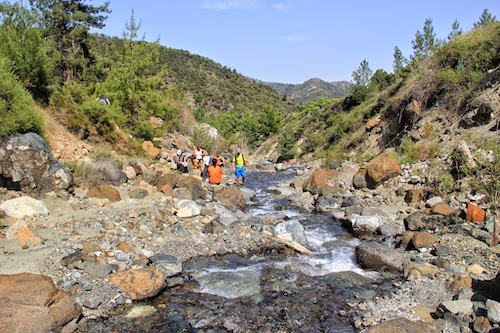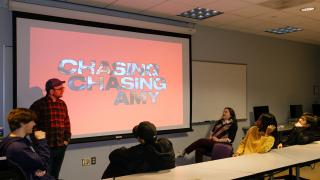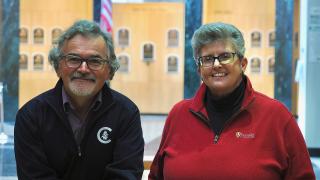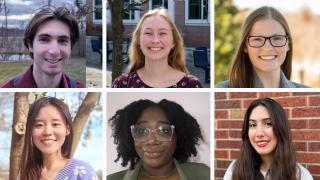
Jacob Napieralski wants his students to dive in—literally.
In Cyprus over the summer, 13 students and the associate geology professor explored sea caves, found a sunken harbor and jumped off a 45-foot sea cliff.
“At first only a couple students halfheartedly raised their hands when I asked who was going in,” said Napieralski, who eagerly jumped from the sea cliff. “Then they got brave. It’s something they’ll always remember.”
These unforgettable experiences—with memorable geology lessons—are what he wanted his students to have while exploring the Mediterranean island for his Field Methods course, GEOL 377/577.
“The classroom is wonderful, but there are limitations. I see this as the ultimate capstone course where they apply what they’ve learned in those 100-, 200- and 300- level classes,” he said. “I also want students to make comprehensive, clear observations and turn them into inferences on how the world works. If they can do that, then they can understand the world around them and transition to any environment.”
During their 14 days on the island, the students learned about more than the geologic formations—Napieralski also taught them about the history, culture and political climate.
“Yes, there are beautiful rock outcrops. But it’s rich in other ways too,” said Napieralski, who conducted research in Cyprus in 2012 as a U.S. Fulbright Scholar.
He said Cyprus is one of the rare places where people can drive through a United Nations Buffer Zone with a flash of a passport. He had his students do that in order to witness the amount of change, like language and food offerings, they’d see just by passing through a gate.
While in the Buffer Zone, Napieralski also had a U.S. Embassy officer meet with students and tell them about the Greek south side of the island and the Turkish north side. “They talked about the challenges faced in Cyprus, like the battle for natural resources, between the north and south sides of the island.”
To get a glimpse of the past, they visited tombs and archeological excavation sites. “There are locations where ancient city kingdoms once stood, only to be destroyed by earthquakes. There’s also an extensive history of farming and mining there. It creates a very intimate link between humans and the natural environment.”
And to understand how to get the best possible view of the island on all different types of terrain, Napieralski had students use a variety of equipment, from buggies to kayaks to a remote controlled Unmanned Aerial Vehicle (UAV).
It was the UAV that helped them find that sunken ancient Roman harbor. Napieralski said the students later realized that they swam right over the harbor’s location; it just wasn’t visible from their perspective.
Graduate student Kim Mobley, whose thesis is on using UAVs in environmental research and data collection, was flying the aircraft.
“I would have never known that there was a sunken harbor there. You realize that you’re seeing something that most people don’t even know about, let alone get the opportunity to see,” Mobley said. “Even now, just when I think about it, I get goose bumps.”
It’s reactions like Mobley’s that motivate Napieralski to organize the study abroad experience. Previous field course classes have traveled to Iceland and Puerto Rico. And, based on the level of student interest, he’d like to plan another trip to Iceland in 2016.
“Moments like jumping off the sea cliff or watching the students’ faces as they see, hear and smell the geysers go off in Iceland confirm I’m doing the right thing,” he said. “They are so enthusiastic. As long as there is demand, we’ll keep exploring.”
For those interested in learning more about the summer 2016 field course, please email Napieralski at [email protected].






